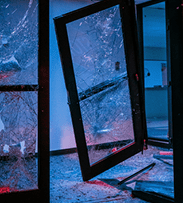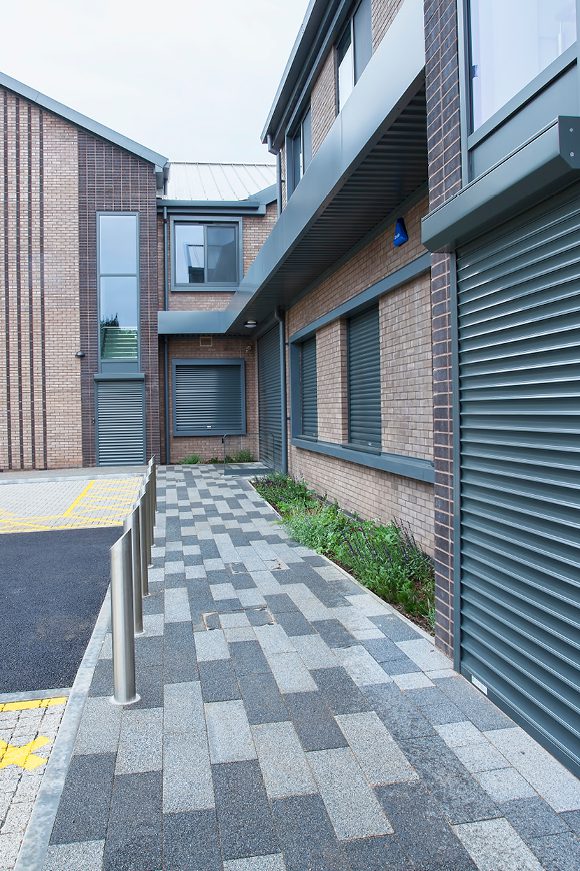

Whilst it is important to make sure that healthcare buildings are secure, it is also essential to make the security measures as discreet as possible. That is why the lintel Integr8 Built-In shutters are ideal for this type of facility as they can be integrated into the building’s architecture with ease.
By design, facilities within the healthcare sector are relatively open. With high volumes of people including patients, healthcare professionals, and contract maintenance personnel, there can be hundreds of people on-site at any one time. Securing the site of this size can be challenging, especially considering the sensitive nature of care. Other factors for consideration include the facility type (hospital, surgery, pharmacy), location (coastal, inland, within cities), environmental crime threat, and international relations.
The healthcare sector is vital to keeping the country functioning and therefore is identified as Critical National Infrastructure (CNI). Along with the sectors Communications and Government, CNI facilities essentially require highly specified solutions to mitigate all potential threats that could directly or indirectly affect the nation. The Centre for the Protection of National Infrastructure (CPNI) provides a wealth of resources for approaching security for CNI projects, of which the solutions integrated must be specified.
Find out how Charter Global can protect your healthcare facility
The NHS is an enormous organisation with a mass of online data sent across cloud-based services daily. Ransomware is more than a risk but rather an ongoing battle. It is unclear why the NHS is so regularly targeted but with healthcare data is 64% more expensive on the dark web, and the vulnerable service area expanding as the public organisation continues to grow, more sophisticated safeguarding measures must be implemented. See our sector page on Data Centres for more details.
On a physical security level, the security measures must act as a preventative to both low- to medium-risk crime and large-scale scale attacks, therefore acting as both deterrence and a safeguard if an incident were to occur.
Healthcare services are widespread with limited funding. Securing facilities that face continual security risks such as robbery is a priority. Medical machinery is expensive, making the theft of equipment a lucrative risk which is why criminals are more willing to take the chance.
Considered a low-level crime, theft is expected within both rural and urban healthcare facilities. Risk of a terror attack, however, are more likely to target healthcare services in large cities or the capital, for example, hospitals with large emergency departments.
Crimes across the risk spectrum will pose a range of attack methods. Historic crime information such as a pattern of attacks on healthcare facilities by location can be provided by the local police authority, useful for profiling risk. Protecting the people and assets inside a building is one thing, preventing property destruction is another – physical security solutions implemented into any property should find a balance between both without compromise.
For private healthcare where funding is of no issue, patients become a greater consideration. Private institutions will never be able to account for every security concern, though implementing high specified products and procedures will mitigate most threats.
The Webster Dictionary describes security as ‘freedom from fear’. For facilities that care for the sick and injured, this is important to remember as there is a similar thought process. Healthcare practitioners are held to high standards of ethical values, providing the same level of care no matter the patient’s circumstance or reputation. Prisoner medical treatment is often a controversial topic but there are also great implications for security.
Ill-health is often associated with vulnerability, however, patients considered violent or dangerous to society will require additional provisions, and the facility will need to allow for secured, private enclosure to treat such patients. Solutions will need sophisticated integration within the building structure to provide secure enclosures and rapid response deployments.
One significant part of the health sectors is mental health care. Psychiatric inpatient and forensic mental health facilities are an interesting division of the healthcare service, with a completely dependent on the level of care and severity. Forensic mental health care is often described as ‘low volume and high cost’ and is dedicated to the care of individuals who pose a risk to others because of their mental disorder.
Medium and low secure services have fixed levels of security, centered around the changing needs of inpatients as they are rehabilitated. Low secure services are highly specialised, dedicated to the care of specific disorders such as autism but their security measures beyond keeping all patients safely inside will be relatively minimal. High secure services, on the other hand, are facilities that work with people who pose the highest level of risk to the public or national services, secured to no less than a Category B prison standard.
For these facilities, bodily force and small weapons are the most critical to defend against. Staff and facility teams will endure substantial training and the facilities themselves will require reinforced entry points including windows and lockdown capabilities.

